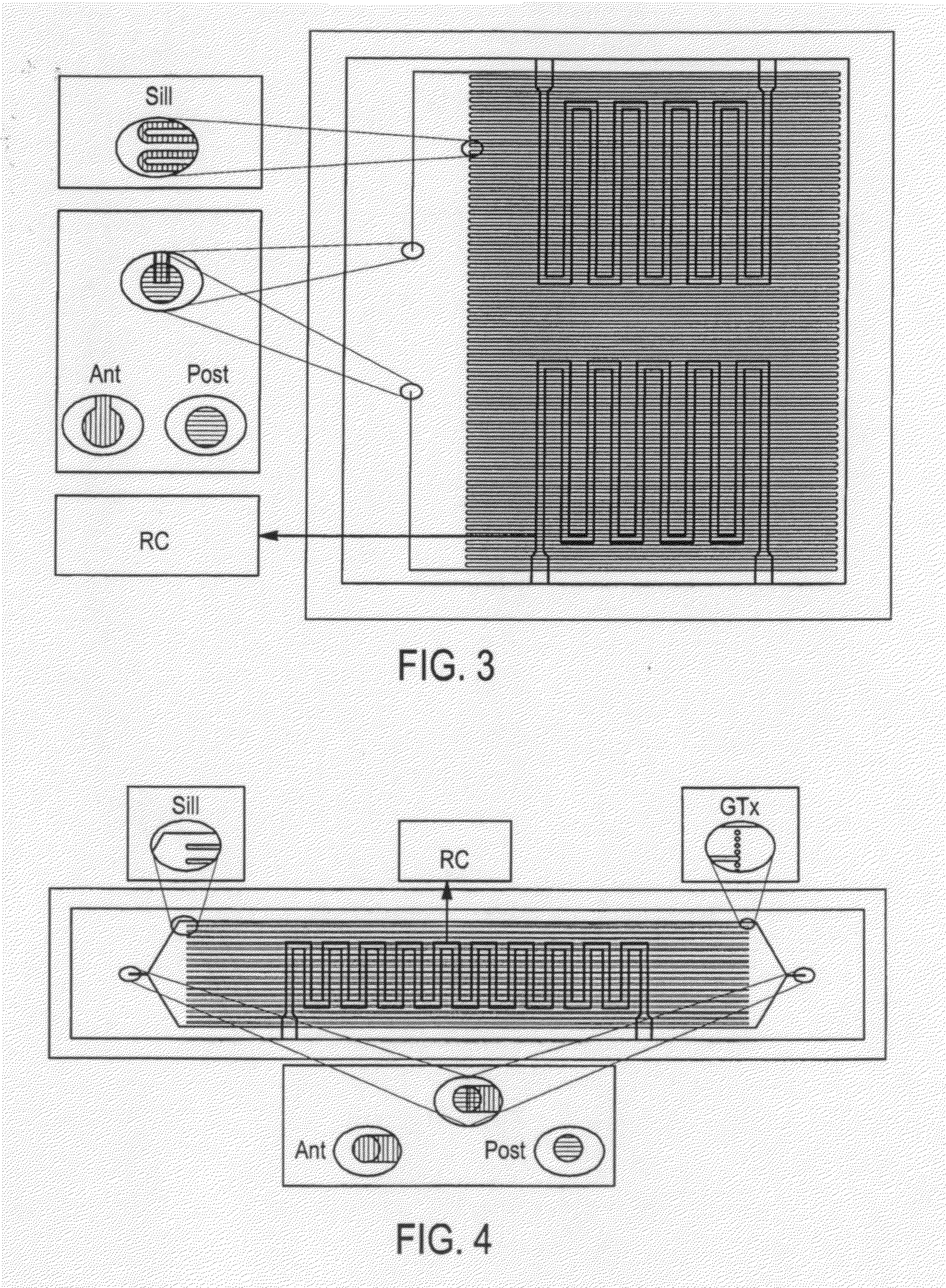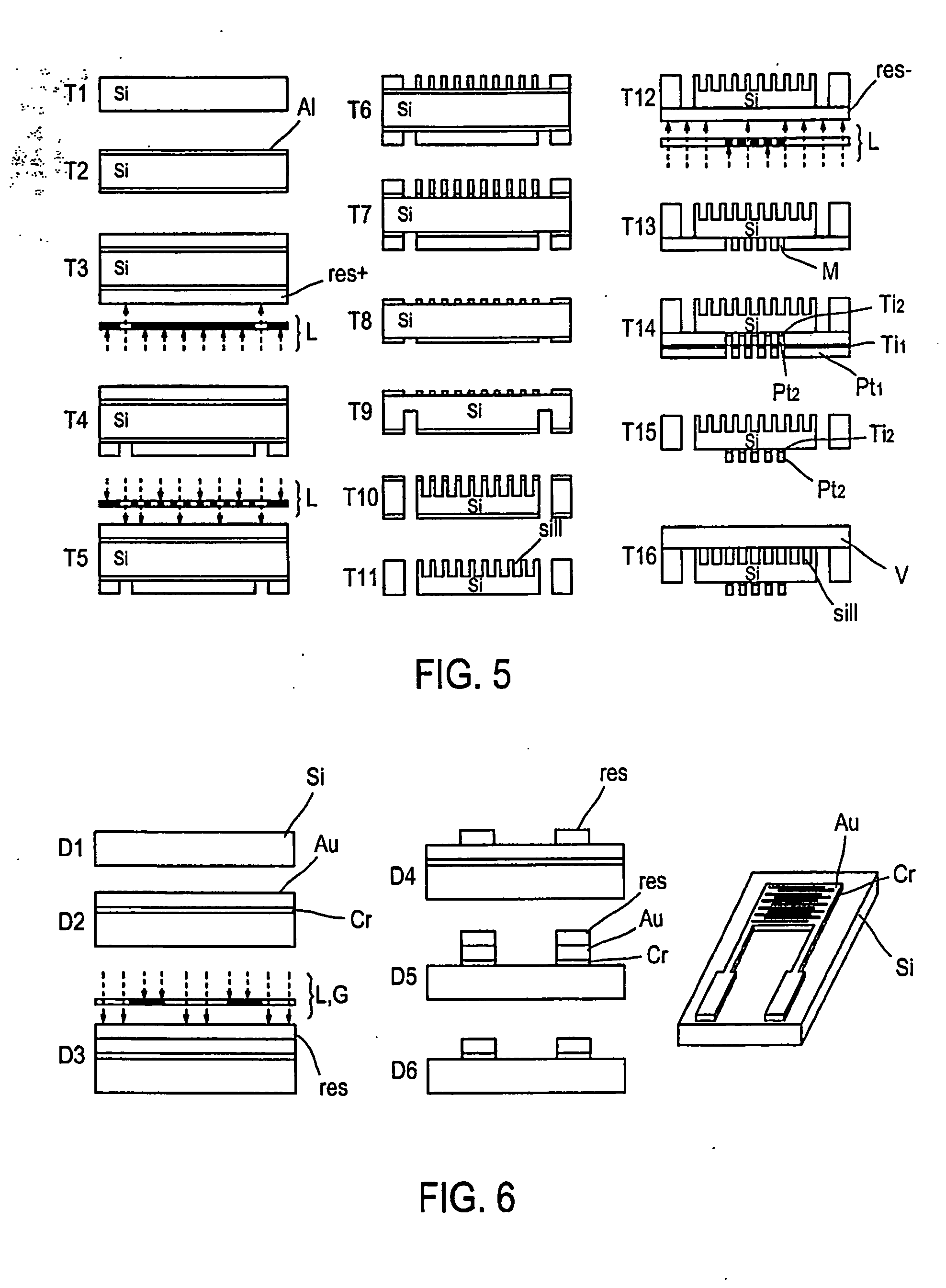Development of a detection microsystem
- Summary
- Abstract
- Description
- Claims
- Application Information
AI Technical Summary
Benefits of technology
Problems solved by technology
Method used
Image
Examples
example 1
First Embodiment of the Device
[0125]The preconcentration module includes a micro-preconcentrator etched on a silicon plate by a DRIE process. The micro-preconcentrator is comprised of 20 grooves 6 cm long, with a rectangular cross-section 500 μm wide and 250 μm long, and has an effective volume of 0.15 cm3. The grooves are packed with resin particles based on 2,6-diphenyl oxide sold under the name TENAX® TA having an average diameter of 120 μm, a specific surface of 35 m2 / g, a porosity of 2.4 cm3 / g and an average pore size of 200 nm. The micro-preconcentrator is closed by a glass plate bonded to the surface comprising the grooves of the first plate.
[0126]A chromatographic microcolumn was etched on a silicon plate by a DRIE process. The microcolumn is comprised of a groove 5 m long, with a rectangular cross-section 150 μm wide and 200 μm long. The groove is produced in the form of parallel loops (or coils) having elbows in the form of an arc of circle so as to prevent the formation o...
example 2
Calibration of the Microcolumn of the First Embodiment
[0129]For the calibration, the sensor array of the device of example 1 was replaced by a mass spectrometer.
[0130]The experimental parameters of the analysis chain are provided in table 1.
TABLE 1Characteristics of the GC / MSParametersAnalysis conditionsThermal desorberTurboMatrix ATD (PerkinElmer)Desorption temperature370° C.Desorption rate50 mL / min Nitrogen N50Desorption time15 minCold trap temperature−30° C.(Tenax TA)Injection temperature300° C.(40° C. / s)Transfer line220° C.temperatureGas chromatograph / Autosystem XL / Mass spectrometerTurboMass(Perkin Elmer)MicrocolumnSylgard 184Vector gasHelium N60Constant pressure37.5 psiTemperature cycle40° C. for 2 min1° C. / min. to 41° C.Plateau for 2 min0.3° C. / min. to 44° C.for 2 min1° C. / min. to 47° C.Plateau for 2 minParameters of the massQuadrupole mode EI,spectrometerscanning (33-400)
[0131]Samples of the target VOCs were passed into the microcolumn to determine the retention time of each ...
example 3
Experimental Methods
3.1 Experimental Device for Polymer Sensors
3.1.A Data Acquisition System
[0133]The experiments were conducted using a system enabling the acquisition of signals from a card comprised of conductive polymers constituting the core of the system.
[0134]The emission chambers are placed outside of the system. A filtration system comprised of a TENEX tube Tx is located upstream of the emission chamber and ensures “clean” air renewal (leakage). Downstream, a PTFE tube enables the connection between the emission chamber and a 3-way solenoid valve. All of the connections are also made of PTFE. The 3-way solenoid valve (sold by the BIO-CHEM-VALVE CORP) makes it possible to select a reference path (air filtered on activated carbon), a sampling path (emission chamber) or a cleaning path (1-butanol / water mixture).
[0135]A pump (sold by the ESCAP company) makes it possible to transfer air of different climates at 147±1 mL / min−1 toward the sensor array confined n a PTFE chamber (in...
PUM
 Login to View More
Login to View More Abstract
- a concentration module (MC);
- a separation module (MS) including a chromatographic microcolumn; and
- a detection module (MD),
- characterized in that it includes at least one first solenoid valve (E3) upstream of the detection module (MD) enabling either to direct a flow containing target molecules toward the detection module (MD), or to direct a flow filtered by a first means for filtering (Tx1), enabling the detection module (MD) to be cleaned when the flow does not contain the target molecules. The invention also relates to a control interface of the device.
Description
Claims
Application Information
 Login to View More
Login to View More - R&D
- Intellectual Property
- Life Sciences
- Materials
- Tech Scout
- Unparalleled Data Quality
- Higher Quality Content
- 60% Fewer Hallucinations
Browse by: Latest US Patents, China's latest patents, Technical Efficacy Thesaurus, Application Domain, Technology Topic, Popular Technical Reports.
© 2025 PatSnap. All rights reserved.Legal|Privacy policy|Modern Slavery Act Transparency Statement|Sitemap|About US| Contact US: help@patsnap.com



